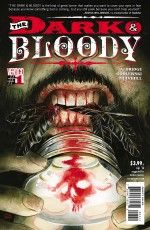Spanning from the woods of Kentucky to the desert of Iraq and back again, Shawn Aldridge and Scott Godlewski's "The Dark and Bloody" #1 introduces Iris Gentry, a soldier with a soft heart amidst hard surroundings. The comic's title isn't a misnomer; there are elements of horror introduced later on once Iris' nature is established, but Aldridge's first mission here is characterization, for both Iris and his wife. In fact, Aldridge's character and story development cruises along just fine even before the horrific mystery is brought in, and its arrival distracts from the overall mood of the story as much as it creates a conflict.
Readers first meet Iris as a boy in the midst of carrying out a cruel and difficult task ordered by his heartless father. Aldridge then briefly jumps ahead twelve years to show Iris' compassion on the battlefield, before quickly flashing forward another dozen years to present day and the general setting of the story, which shows Iris as a caring husband if opportunistic moonshiner. Aldridge uses the time jumps and bouncing narrative to establish Iris as a good-natured and all-around likeable guy before bringing in his wife, who's shown to be a loving, likeable character who is tolerant of Iris' bootlegging venture.
Aldridge uses a good deal of exposition to cement these characters' natures and -- despite being a little choppy -- it serves its purpose well. While there are some possible vague hints and speculative implications that some kind of horrible menace lurks about, its eventual appearance comes across as an almost unwelcome twist. With no outward mention of anything the least bit unusual afoot within the story's rural confines, the appearance of a shadowy, clawed, murderous creature is surprising for the wrong reasons as well as the right ones. The first issue gives no indication that any of the earlier events give way to later ones, and -- while this might play out better when read as an eventual collected volume -- the first issue becomes a little bit disjointed as it unfolds.
Disjointed or not, Godlewski successfully captures the mood; the dark and secluded woods convey an atmosphere ripe with potential for something horrific, and Godlewski's glimpse of the deadly creature -- while mostly unseen -- works well because of his discretion. Godlewski's layouts establish a scene and then reveal more about it with each panel, a technique that works especially well if this comic is read digitally panel by panel.
Whether read digitally or in floppy form, Godlewski makes Aldridge's story flow effortlessly; there's no need to scrutinize or study individual panels, characters are all readily recognizable and his lines are simple, avoid needless complexity and don't try to impress with technique. Similarly, colorist Patricia Mulvihill is content to just present Godlewski's art without trying to overtake it.
"The Dark and Bloody" #1 achieves the most important step of a character-driven story: defining the characters. It missteps a bit beyond that, but nonetheless manages to establish a decently compelling introduction.

